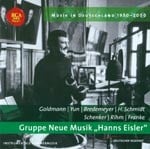fl(=afl).cl(=bcl)-perc-pft-vln.vla.vlc.db
Abbreviations (PDF)
Bote & Bock
The title Pièce concertante alludes to design ideas from which concerto form began to emerge in the 17th century: the grouping of instrumental choirs with solo instruments.
- The composition is characterised by three layers of sound, each with equal importance: the strings act as the basic layer, and are contrasted with the woodwinds (flute and clarinet), which are mainly played in parallel. Piano and percussion form a third, mediating layer of sound. These three sound groups are heard both successively and simultaneously, with each of the players also taking on soloistic roles.
- Yun develops the concertante principle in ‘rival’ (or competing) sound processes: The soloistic emergence of individual instruments and the economical use of the richly scored percussion make new sound colours and instrumental combinations possible in each case.
- The concertante gesture is overarched by a second, dramatic principle: the idea of drawing together layers of contrasting material. This dramatic layering draws the various ideas previously heard together, forming an intense unity of opposites played across the several stages of development.
At the opening of the 15-minute work, Yun introduces the three layers of sound - strings, piano (with percussion) and woodwinds - one after the other, each in its own (and therefore contrasting) idiom. Glissando gestures and long sustained notes from the strings (supported by the piano) are followed by the flowing movement of a ‘sound bridge’ (Korean: yonum) formulated by the piano with percussion. The woodwind duo then appears as a third layer of sound with signal-like calling gestures. At the end of this first formal section, all three sound groups are heard simultaneously for only a few seconds: they meet but remain caught up in their respective different idioms.
The second section of this first part is introduced by a violin solo and culminates in an initial meeting of the sound groups. This is supported by the sounds of antique cymbals, alongside gestures from the woodwinds and piano together (tonally and rhythmically) in an intense fortissimo idea, while the strings carry their own material (tremolo glissando gestures) at the same time, but independently of this ‘union’.
The third section of the first part is characterised by an initially relatively calm and quiet sound building in the strings. Above the string sound, upward octaves in the woodwind alternate (in long sustained notes) with melismas in the piano and vibraphone. Flanked by temple blocks, gongs and the piano, the strings then develop counterforces by ‘seeking support in the depths’ (Yun). In this phase, Yun combines the sound gestures of the string section with the gestures of the sound group of piano and percussion.
Yun articulates the search for unity in the slow middle section by switching from the previously formed sound groups in favour of instrumental solos. A flute solo is followed by an extended clarinet solo and an epilogue of light trill chains in the piano and vibraphone, after which the double bass and cello emerge as soloists.
The lively third section begins with a glissando motif in the flute, reminiscent of the dominant idea heard earlier in the strings. The clarinet and flute voices unite in a duet. Short glissando motifs from the strings add commentary. Impulses from the snare drum then introduce the next idea with the unification of the string and wind section in a powerful climax, in which the piano and vibraphone also participate. This unity is nevertheless only temporary. After reaching this climax, the sound groups separate again and fall back into their divergent idioms. A passionate violin solo accompanied by the percussion is answered by trill fields from the woodwinds. Violent double stops by all the strings contrast with wide-ranging upward gestures by the woodwinds.
A calm ‘island of sound’ serves as a transition to the final section: a piano solo with soft percussion sounds (cymbals, gong, temple block and vibraphone) is heard above a static string section. To further unite the sound, the wind instruments now switch to alto flute and bass clarinet. Their delicate duet in the lower register is followed by the piano, also in two voices and with simple sustained notes. The strings join in with an imitative texture and a process of growth begins. ‘The string sound should be almost ‘elegiac’’ is noted in the score, as if the fusion now achieved for the collective sound formation of all groups was bought at the price of individual freedom. The short final stretta, in which the groups separate again, indicates that the unity achieved here is also only an illusion.
Walter-Wolfgang Sparrer (1999), Translation: Boosey & Hawkes

Gruppe Neue Musik „Hanns Eisler“ / Christian Münch
(Deutscher Musikrat – Musik in Deutschland 1950–2000; Instrumentale Kammermusik: Gruppe Neue Musik „Hanns Eisler“)
RCA Red Seal 74321 73626 2
